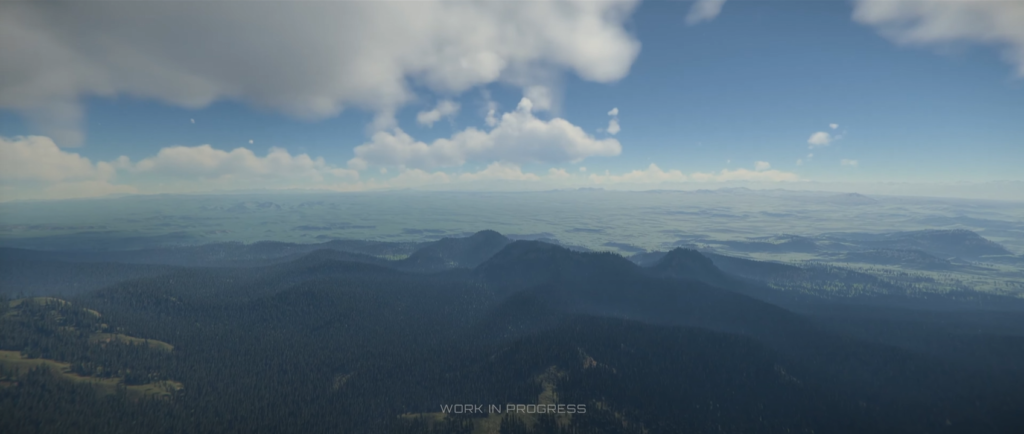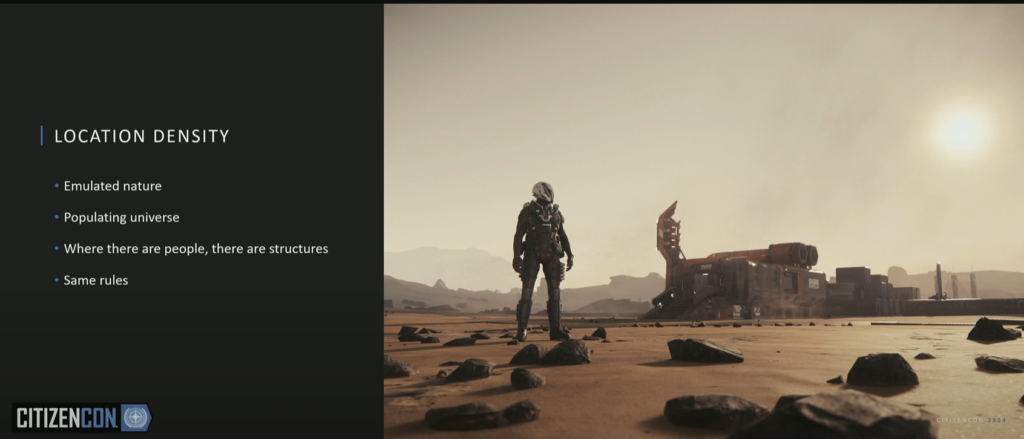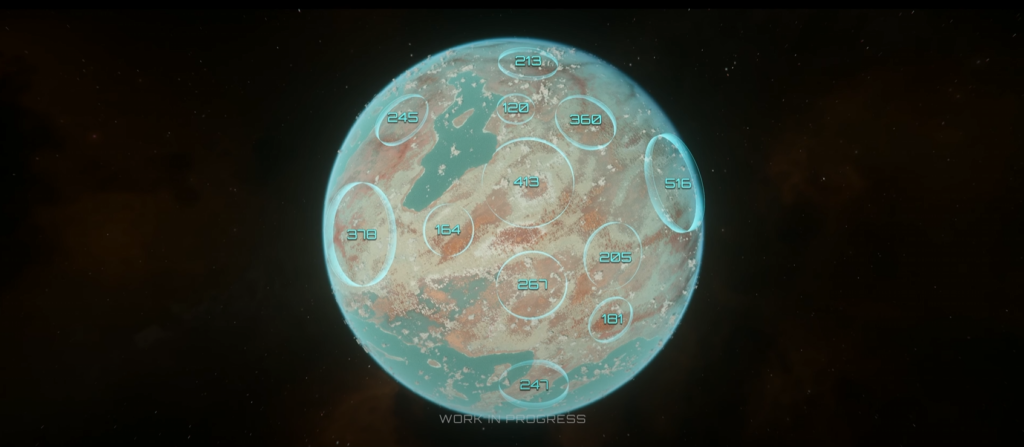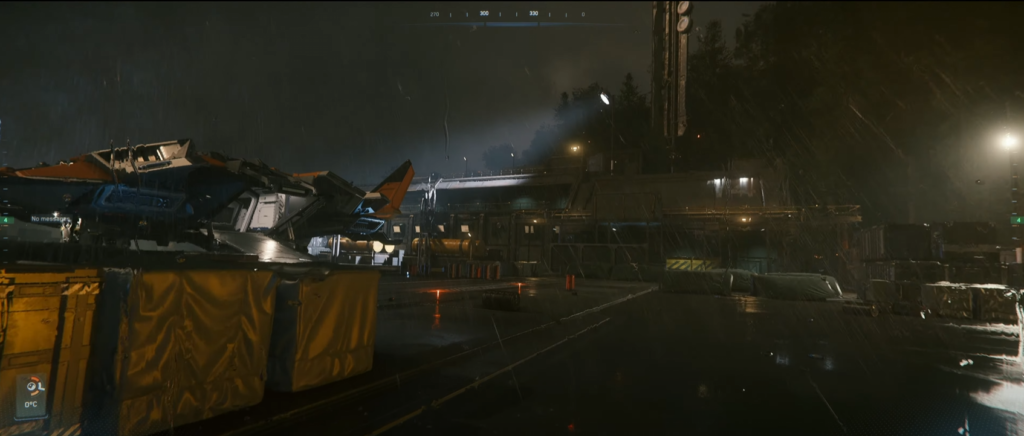This year’s show was weird: there was no big keynote. Chris Roberts make his obligatory appearance but quickly vanished in keeping with CIG’s apparent mandate to keep the controversy-magnet out of the camera’s eye. Instead, the show about a video game about flying space ships opened with a presentation…on grass and trees.

Star Citizen started out as a Kickstarter, and the original premise was that it would be the “spiritual successor” to Freelancer, another game by Chris Roberts. In this version, players would only “land” on planets via menus, there would be no ambulation, and all gameplay would take place from the cockpit of the player’s ship. Over time, Star Citizen grew in scope and ambition. Now, players can seamlessly transition from space flight to planetary atmosphere, and land anywhere on one of four planets and several moons, all of which exist at scale.

Biomes
Because Star Citizen is both a simulation and doesn’t plan anything half-assed when 16 asses will do, how a planet looks and how it is represented matters. To that end the new planetary tech point-release, creatively named “Genesis”, is designed to simulate planetary composition and conditions in ways that allow the planets to populate themselves with grass, trees, rocks, resources, and even settlements and NPCs.

Part of the impetus for this is biome diversity. Right now, there are a few notable planetary biomes like wintery tundra, conifer forests, rocky desolation, and one gas giant. Each of these are hand-crafted according to the science of how we believe biomes work. With Genesis, flora and fauna will have their own conditions for growth and sustainability, and by coding planets with data points such as soil type, soil depth, temperature, acidity, liquid presence and saturation, mineral deposits in quantity and quality, and even competition from other species, CIG hopes that their biomes will simply…generate themselves.

In order to simulate a wider range of diversity, then, CIG needs to up its game when it comes to biome types. We saw examples of swamp biomes, jungle biomes, and a Redwood forest complete with Drake Dragonflies zipping between the trees, which you might remember from one of those early 1980’s art-house sci-fi films.

This isn’t the only goal. One issue with massive, open landscapes is that texture tiling quickly becomes apparent. One issue with Star Citizen (and other games) is that in order to conserve memory, sometimes textures re-arrange themselves based on viewer distance, leading to the sensation that terrain features are “popping in”.

CIG is handling this by creating dynamically sized regions of a planets surface that dictate what needs to be rendered and when, and then resizing those plots based on visibility. The result is that there’s no more sudden rearrangement of trees or mountains as a player descends to the surface.
Settlements and NPCs

On the far more ambitious end, Genesis is also being primed to start throwing down settlements and NPCs. Currently, NPCs and POI exist in the game either as massive cities, small outposts, abandoned settlements, underground bunkers, or the newly released distribution centers. In places where NPCs are, they’re just window-dressing. They will mill about, taking different poses that aren’t always fitting their environment (staring at a blank wall like it’s a work of art to be scrutinized, for example), and only the shopkeepers and guards have spoken lines.

As part of the mandate to “bring life” to the game, Genesis’s sub-module “Starchitect” will create settlements in places and of types that make sense based on the planetary data. For example, mining outposts will be generated where there are significant sources of minerals beneath the surface. This settlement will include what we’d expect from a mining outpost: mining equipment, houses for workers, and power sources to keep it all running. Devs can then review the placement and the elements and tweak them as necessary by adding or removing buildings, rearranging them, or even expanding the criteria such as adding access to water as a necessary data point when determining where to place the group.

When 2.34 was released, it was mentioned that the new cargo missions would be “logical” in that they would ask players to pick up raw materials at outposts, take them to refineries, and then take refined materials to manufacturing and distribution centers, simulating a kind of supply chain that one would expect in a real-world scenario. Genesis will also use these rules when placing settlements by creating a distribution center surrounded by forward operating bases. These would then be in proximity to mining outposts, which themselves would be placed near caves where raw materials might be found. The result is a sprawling and logical placement of groups of buildings, each with purpose, that can house NPCs and provide sources and destination for player interaction, commerce, and missions.

Environments
Moving slightly away from Genesis, the presentation shifted to other environmental aspects that CIG was adding or improving, starting with lighting.

Lighting in video games might usually be set in service of narrative design, and because of this, it is more of a feature for players to contend with than it is for NPCs. In a light or dark environment, NPCs can be purposefully coded to behave certain ways that mimic an average person’s perception under specific conditions; light makes things easy to see, so an NPC’s detection range can be larger, and darkness makes things difficult to see, so an NPC’s detection range is made smaller. Players, however, have to rely on artificial light and perceived motion with the stupid water-bags we call eyes. This boils down to lighting being the deciding factor in artificial parameters versus natural responses, and it’s usually OK from a gameplay perspective. But CIG’s gonna CIG, though, and will be trying to replicate human eyesight and abilities in their NPCs that changes based on lighting conditions.

They are also working on improved cover mechanics. While players can determine what is “good” cover and what is not, NPCs aren’t necessarily that smart. The new system will also allow for mobile objects such as the Ursa in the image above to be recognized as viable cover.

Keeping the excitement rolling, the presentation segued into a discussion of sound. Sound, of course, is sometimes more important than visuals when it comes to realism; we can appreciate high-rez graphics and say “yes, that looks real”, but I think that audio is often left at “good enough” in 5.1 or 7.1 surround to concentrate only on position in relation to the player. In this segment, we were shown how, for example, sound will be affected by distance. A sniper fired a shot at a Pico some distance away, and from the Pico perspective, we heard a squeak of the toy being hit, and then followed by the distant crack of the rifle being shot. They also talked about weapons and explosions, and the results were pretty impressive.

And then we have clouds. Clouds have been in the game for some time, but were pretty damn unimpressive for a good long time. Whether it was my new PC or further advancements in the display tech behind the game, cloud appearance has improved significantly to the point where I now love seeing the clouds from space with shadows, and from the ground with God rays.

But real clouds don’t just look pretty. They move, they shrink and vanish, and appear and grow, and the new cloud tech was shown to do all of those things. Like biomes, clouds will use planetary data to determine where to form and under which circumstances to get all nasty.

Some planets may alternate between pleasant weather and moderately severe weather, while others will be designed in ways that always generate nothing but the worst weather imaginable. And yes, there’s lighting, and yes, it can be dangerous when flying.

Thoughts
It was bold to open this convention with such a discussion. As much as the game is about space ships and flying them, the Brave New Worlds panel set the tone for the rest of the show by focusing on aspects of upcoming features that are designed to breath life into the universe.
Of course, my first thought was “is this another revamp of their planetary tech?” The original Star Citizen launched with planets, but they got a glow-up with their “Planetary Tech” tiered plan. We started with tier 1, then moved into tier 2, and I think the live game is currently in tier 3. Was this tier 3.A? Are they really going back to the fucking well again with another revamp of a major bedrock feature?
Ultimately, the answer is no, this is an improvement, and Genesis is not a replacement for the existing tech. In fact, when I thought about it some more, and with a bit of foreknowledge, I did the math. If the game is going to ever launch to the now mythical “1.0”, then CIG cannot afford to devote manhours to the tedious tasks of creating planets, designing biomes, and laying down settlements and NPCs by hand. They need to be able to drive the procedural generation of these massive features through data so that they can look at a literal spreadsheet and compare all of the planets they have or want to create, and ensure that we don’t have the “Elite Dangerous Problem” where players can land on planets and moons, but are hard-pressed to tell one from any other. Genesis should allow the designers to crank out first-pass planets in a matter of months, weeks, or maybe even days, and then give them a polish pass to ensure that (settlements, especially) actually do make sense in the ways they were created. Ultimately, Genesis was created to ramp up production. That it includes improvements to things like terrain, light and sound, and cloud and weather-tech strikes me as a knock-on opportunity and was not the original intent for pushing ahead with this. There is absolutely no reason why the game could not hit 1.0 with the current planetary visuals and improve them over time. However, I don’t believe CIG could even consider talking about 1.0 if they had to build planets and moons by hand. Genesis does a lot of cool things, but the coolest of all is the most boring to talk about: procedural generation.





